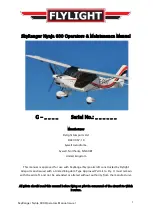
45
Accelerating:
For better penetration in headwinds you can fly faster by using the accelerator
system. Using the accelerator decreases the angle of attack and can make the gli-
der more prone to collapse. Therefore excessive use of the accelerator near the
ground should be avoided.
Before using this system it should be well adjusted.
Make sure it is attached properly.
Adjust its length such that you are able to achieve maximum travel
with both speed pulleys on the riser touching, while at the same time it
is not activated while launching or flying at trim speed with the pedal
released.
DO NOT USE THE ACCELERATION SYSTEM AND BRAKES AT THE SAME
TIME! IT IS VERY DANGEROUS TO USE THEM BOTH SIMULTANEOUSLY
WHILE FLYING YOUR ICE2 XC AND CAN RESULT IN SERIOUS COLLAPSES.
Active Flying
All good pilots react to the feedback their gliders send them, and are constantly
adjusting their speed, pitch and roll to match its movements in the air. As the glider
pitches in front of them they use the brakes to slow it down. Similarly, as the glider
drops behind them, they release the brakes to speed it up. These movements can
be symmetric or asymmetric: so they may be applying both brakes or one. They
may also roll their bodies with weight shift to move with the glider when the glider
rolls to the right or left. These subtle adjustments keep their gliders flying smooth-
ly and directly above them. These are skills that can also be learned from the safe-
ty of practicing ground handling in a park while on small grass hills or even flat
fields, using a steady wind, while kiting the paraglider overhead.
Landing
The
ICE2 XC
is very easy to land. Always stand up in the harness in the lan-
ding position very early in order to be able to react as fast as possible to sud-
den events. Give yourself plenty of options and a safe margin of error. Set up
your final landing leg to face into the wind to minimize groundspeed. Once
below 25 meters avoid turning tightly as the glider will have to dive to accele-
rate back into normal flight. If you are at a low altitude, or if you hit sink, this
could mean you hit the ground harder than expected. Be prepared to do a
parachute landing fall (PLF).
Once below 25 m and on final landing approach, the glider should be allowed
to fly at trim speed by going "hands up" with the brakes. This allows more
energy to be converted into a full flare. Then, 2 m above the ground, both bra-
kes are applied smoothly and forcefully to full arm extension, below the seat of
the harness, resulting in a full flare and reduced speed on landing. In stronger
winds, the flare can be reduced or eliminated to prevent being blown back
when landing.
Towing:
Your
ICE2 XC
is also designed to permit winch towing. Be aware however,
that getting towed is more complex than foot launching, because there is addi-
tional equipment and a towing operator, all of which must be perfectly coordi-
nated to work together. When getting towed always be sure that you perform
a pre-flight check of your equipment. Then be sure to do a pre-flight check of
all the tow system winch components, your tow bridal release system and sig-
nals to communicate between pilot and tow operator. Before increasing the
tow-line tension for takeoff, check that the wing is properly inflated and direct-
ly overhead. After that, give your supervisor the okay sign. While getting
towed, it is important that the towing force does not exceed 100 kp. Generally
the towing force should equal the weight of the towed pilot.
It is very dangerous to tow pilots who do not have a towing-licence or without
instructor supervision. Also every component of the towing equipment (har-
ness, winch and release bridals) should have certification that declares confor-
mity for towing. Also be sure that you work with an experienced team that you
trust.
Содержание ICE2XC
Страница 14: ...53 53 ICE2 XC S ICE2 XC S...
Страница 17: ...56 56 ICE2 XC L ICE2 XC L...
































